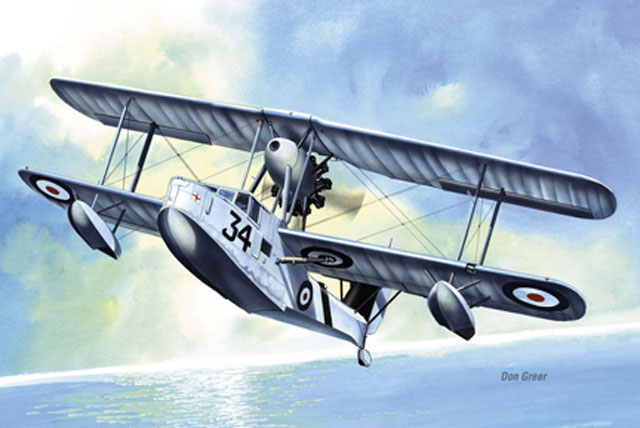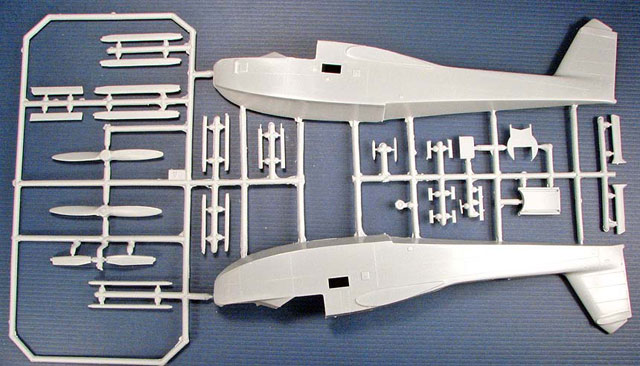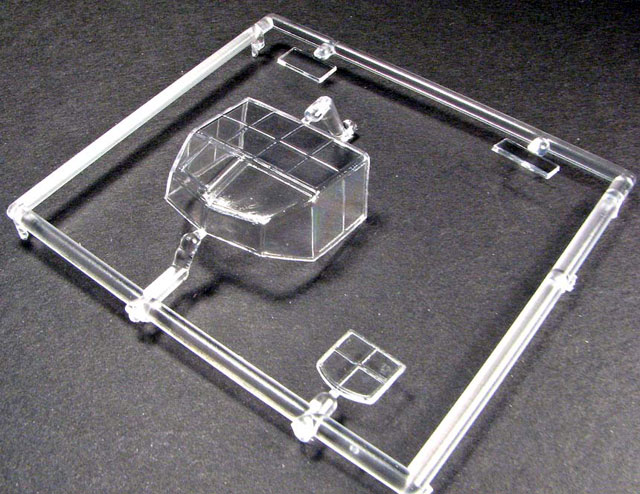|
Supermarine Walrus

Classic Airframes
S
u m m a r y
|
| Catalogue Number: |
Kit No. 4105 - Supermarine Walrus |
| Scale: |
1/48 |
| Contents and Media: |
65 parts in gray styrene, 56
parts in cream colored resin, and 4 clear injection molded parts for
windshield and windows. Instructions, 2 decal sheets and painting guide
with markings for 8 aircraft. |
| Price: |
USD$55.00 |
| Review Type: |
Another FirstLook |
| Advantages: |
Excellent decal selection, Injection
molded clear parts. |
| Disadvantages: |
Difficult build |
| Recommendation: |
Highly Recommended |
Reviewed by Steven "Modeldad" Eisenman

Classic Airframes' 1/48
scale Walrus
is available online from Squadron.com
Well, its back; the Walrus from Classic Airframes.
No question this kit has a reputation as being a difficult build. But
what are we to really make of this Walrus?
Is the Walrus a symbol of death as ascribed to the
Beatles lyrics “… I am the walrus Goo goo g'
joob” (was the Walrus Paul?)? Or does it lead modelers to their demise,
as the Walrus in Lewis Carroll’s “Walrus and the Carpenter” led those
poor oysters to their demise? Many a modeler, I’m sure, has said the CA
Walrus is a killer.
But maybe, perhaps, the
CA Walrus as modeling death or killer is all myth, for there have been
produced some very fine models from this kit. I point you to two very
fine works by
John Valo and
Barney Dunlevy.
Okay, let’s start by counting rivets, and the Mk. I
Walrus had thousands of them.
The Mk I had a metal hull, while the Mk. II had a
wood hull. The CA Walrus, while not covered in rivets (or any
representation there of), is a Mk. I, with the horizontal windshield to
nose decking and curved fuselage top edges.
Is the absence of rivets a problem? That will
depend on the opinion of each individual modeler. While in most
close-up pictures the rivet pattern is discernable, in most pictures
taken at a distance, the sides appear smooth. Given the slab sided
hull, I’m sure any modeler will find it not difficult to add rivets
using a “Rosie the Riveter tool” or some variation of it, if they so
choose.

Click
the thumbnails below to view larger images:
On with rivet counting. I placed the major parts
of the CA Walrus on a 150% enlargement of the Walrus plans that came
with the
Mushroom Model Magazine monograph on the Walrus and Stranraer.
Assuming that the drawings are accurate (and in this day in age that is
a risky assumption with regard to any drawings), the only issue I
perceive is that the rudder appears to be too narrow in chord.

One improvement over the first issue that many will
welcome are the injection molded clear parts. They have good clarity
and well defined frames.
Markings
The decals are printed
by Microscale are well printed and in register. Not only do you get the
decals for the first boxing, but you also get a second sheet with
markings for pre-war aircraft. The decals include those most odd foot
print wing walk markings. They appear to have been used on all the
Aluminum Dope aircraft. When it comes to the camouflaged Walruses, it
is hit and miss, and without photographic documentation, it is your
call.
Click
the thumbnails below to view larger images:
The following Walruses
are all in Aluminum dope and natural metal.
-
714 Squadron, HMS Manchester, L2253,
1939.
-
715 Squadron, HMS Suffolk, K8552,
November 1938
-
No. 715 Flight, HMS Cumberland, K5780,
1937
-
No. 720 Flight, New Zealand Division,
Royal Navy, HMS Achilles, K5774, 1937-38
Camouflaged Walruses:
-
700 Squadron, FAA, HMS Shropshire, K8548,
1940 – 1941: This aircraft is in a four colors shadow-shading
topside scheme. The upper wing is Extra Dar Sea Grey and Dark slate
Grey, as is the top of the fuselage. The lower wing is in Dark Sea
Grey and Light Slate Grey. The lower part of the hull is in Sky
Gray.
-
No. 8 Communications Unit, RAAF, P9275,
1943: Extra Dark Sea Grey and Dark Slate Grey wing tops and hull,
with the undersides of the wings in Sky. The instructions note that
it is not determined whether the lower wing was shadow-shaded.
-
700 Squadron, K5762, Aboukir, Egypt:
Dark Earth and Middle Stone with Azure blue underneath. No
shadow-shading. I have my doubts about this scheme, as only black
and white pictures exist, as far as I know. It could be an
undocumented legend, as may be the case with the Desert Scheme
Swordfish.
-
HMS Cumberland, P9561 Operation Torch,
1942: Shadow-Shaded with Extra Dark Sea Grey and Dark Slate Grey
upper wing top and upper hull, with Dark Sea Grey and Light Slate
Grey lower wing-top and lower hull. The instructions seem to have a
misprint in that the top-plane view indicates that the aircraft is
not shadow-shaded.
To all those who appreciate odd aircraft and those
who have a slightly masochistic streak, I highly recommend this newest
reissue from Classic Airframes. In all seriousness, while clearly a
challenge, it will certainly be a unique and eye-catching addition to
any modeler’s collection. You have been warned, now take a risk. I may
even follow my own advice.
Highly Recommended.
Supermarine Walrus & Stranraer, Kightly and
Walsgrove, Mushroom Model Publications, 2004.
Review sample provided courtesy of Classic Airframes.
Classic Airframes
kits are available worldwide through hobby retailers and from
Squadron.com
Review and Images Copyright © 2005 by
Steven Eisenman
Page Created 12 December, 2005
Last updated 12 December, 2005
Back to HyperScale Main Page
Back to Reviews Page
|
Home | What's
New | Features
| Gallery |
Reviews | Reference
| Forum
| Search